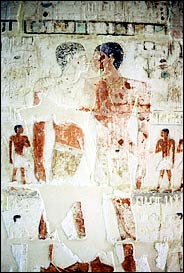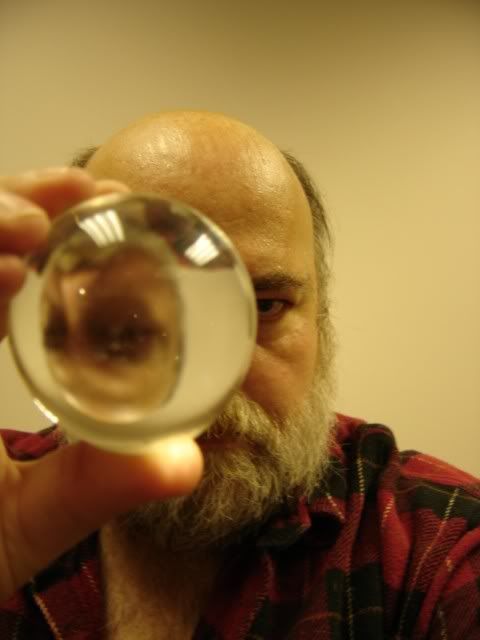Digging up gay history

Once upon a time 4,300 years ago in ancient Egypt lived two men, Niankhkhnum and Khnumhotep, who served in the honored position as chief manicurists to the king. We know this because archeologists uncovered the tomb of the two men 41 years ago not far from Cairo. There were no mummies in the tomb, but what archeologists discovered was even more enigmatic: stylized paintings on the wall depicting Niankhkhnum and Khnumhotep in a close embrace. Just what that embrace represented has been the subject of heated speculation ever since. Were Niankhkhnum and Khnumhotep lovers? Were they brothers, or perhaps even twins? Were they "just good friends?"
Now, according to a recent article in The New York Times, a researcher has offered yet another explanation for the arm-in-arm pair of Egyptian men. David O'Connor, a professor of ancient Egyptian art at the New York University Institute of Fine Arts, pooh-poohs the idea that the pair were gay and has opted for an even more implausible explanation: the men were not only twins, but conjoined, or Siamese, twins.
O'Connor reasons that ancient Egyptian nobility had a fascination with physical disabilities. Dwarves, he notes, held an exalted role in the palaces of kings. Far from being seen as "freaks," persons with abnormalities were viewed as proof that the gods could form any sort of body. The fact that a body might be drastically different from the norm was considered a mark of special favor from the gods.
Meanwhile, others find fault with O'Connor's conjoined twins interpretation.
Opposition to his proposal promises to be spirited. Most Egyptologists accept the normal-twins interpretation advanced most prominently by John Baines, an archaeologist at the University of Oxford in England.
"It's a very persuasive case Baines makes," Dr. O'Connor acknowledged.
And he noted that the gay-couple hypothesis had become the popular idea in the last decade. A leading proponent is Greg Reeder, an independent scholar in San Francisco and a contributing editor of KMT, a magazine of Egyptian art and history. The most Google references to the tomb, archaeologists say, concern the homosexual idea.
The gay argument leans on the analogy with depictions of married heterosexual couples in Egyptian art, which was first suggested by Nadine Cherpion, a French archaeologist.
Because the embraces of heterosexual couples in the tomb art convey an implicit erotic and sexual relationship, and perhaps the belief of its continuation in the afterlife, Mr. Reeder and his allies contend that similar scenes involving the two men have the same significance, that they presumably are gay partners.
Calling attention to the most intimate scene of the two embracing men, Mr. Reeder said: "They are so close together here that not only are they face to face and nose to nose, but so close that the knots on their belts are touching, linking their lower torsos. If this scene were composed of a male-female couple instead of the same-sex couple we have here, there would be little question concerning what it is we are seeing."
As happens so many times with historical artifacts that might carry a same-sex connotation, many researchers tend to ignore them at best or sweep them under the carpet at worst. Many prestigious museums have objects depicting what could clearly be considered same-sex representations in their collections, but either keep them locked away from public view or concoct innocuous interpretations of them so as not to shock the sensibilities of museum visitors.
What's particularly telling is the statement about a "gay" interpreation of the Egyptian tomb painting being somehow putting a 21st century spin on ancient cultures. Apparently homosexuals didn't exist in history, they seem to say, so why would this painting depict two gay men?
I guess it never occurs to researchers that refusing to consider that the men depicted may be involved in a romantic relationship puts a layer of 21st century homophobia over their interpretations. Likewise, it apparently doesn't occur to researchers that homosexuals, who differ from the norm, might also be considered as oddities and worthy of veneration (just as they were among some Native American tribes).
Granted, not much is known about homosexuality in ancient Egypt, but a lack of evidence uncovered thus far does not necessarily mean it wasn't recognized. Too many researchers who refuse to accept a same-sex relationship explanation for Niankhkhnum and Khnumhotep are simply trying to avoid having to rethink accepted ideas of Egyptian culture that date back to the 19th century - a time when homosexuality was neither discussed nor accepted.
Part of the problem is that, before the term "homosexual" was first coined by a German researcher in 1869, there was no terminology to describe same-sex love. Even the general, all-purpose word "sodomite" was imprecise and could include everything from bestiality to having sex with one's wife in a position not given official church sanction to homosexuality.
Thanks to ground-breaking research by people such as the late John Boswell who wrote Christianity, Social Tolerance and Homosexuality, historian Martin Duberman, Jonathan Ned Katz, author of Gay American History, Bryn Fone, author of Homophobia, and others, there is now evidence out there that homosexuals have existed throughout history and their acceptance or rejection has swung back and forth at different times in different cultures.
Still, traditional research is slow to embrace the upstart field of gay studies. Look at the uproar that accompanied the publication of the late C.A. Tripp's The Intimate Life of Abraham Lincoln that dared to suggest the beloved president might have enjoyed romps with men while Mary Todd Lincoln was out of the White House and that he carried on a four-year relationship with shopkeeper Joshua Speed. There were parts of Tripp's book that I felt reached a bit too hard to make his case, but the reaction by traditional Lincoln scholars to the book often said more about their own views of homosexuality than their opinions of Tripp's research and hypotheses.
History, it is said, is written by the victors. In the case of the history of same-sex love, it seems that history, when it's written at all, is written by the homophobes, consciously or unconciously.
While right-wing politicians and pundits argue that academia skews far to the left, that's not the case when it comes to researching "gay history." A few progressive universities offer courses in gay history, but they are the exception. As a result, depictions in words or painting or other relics that might re-write history books or at least force some reexamination of long-held ideas, end up getting buried or denied. And the rightful place of LGBT persons throughout history is the worse for such denial.


<< Home